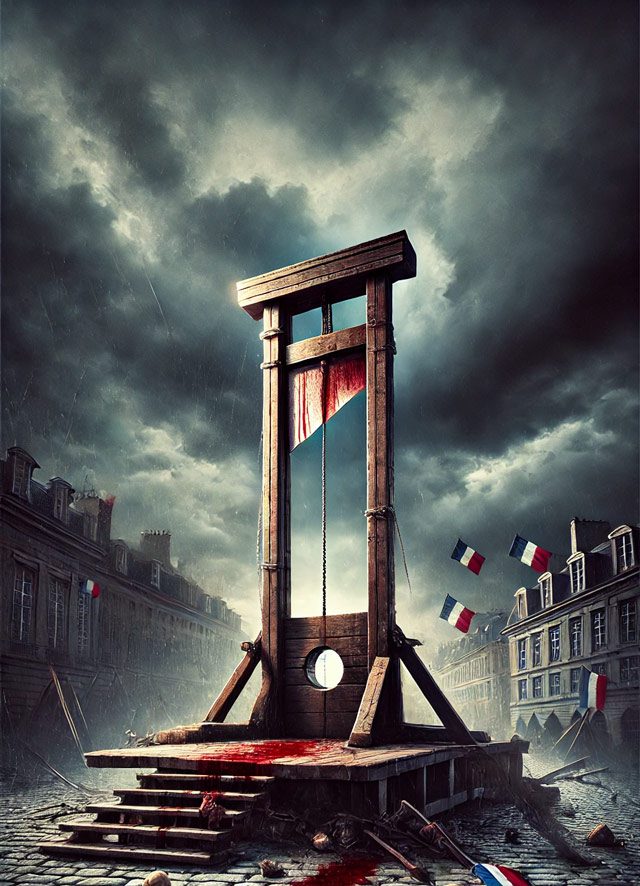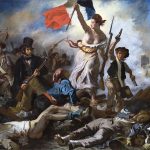
The guillotine is often seen as a grim symbol of the French Revolution. It evokes images of fear, death, and a dramatic turn in European history. However, its legacy extends beyond its brutal use. In the world of visual arts, the guillotine has been an enduring icon—both terrifying and fascinating. This article delves into the macabre history of the guillotine in visual arts, focusing on its role during the French Revolution and its lasting influence on artists. Buckle up for an art history journey that’s equal parts gruesome and enthralling.
The Guillotine: More Than Just a Death Machine
The guillotine didn’t just execute people—it executed an era. Known as “The National Razor,” it represented not only the terror of the Revolution but also the ideals of equality. After all, it claimed the heads of both royalty and commoners alike. That irony wasn’t lost on artists, who found themselves both repulsed and mesmerized by this deadly device.
During the Revolution, many artists began to incorporate the guillotine into their works, blending the boundaries between politics and art. The guillotine wasn’t merely a subject; it was a statement. Jacques-Louis David, a central figure of the period, painted scenes that captured the intense political climate, often featuring symbols tied to revolutionary ideals—including, sometimes subtly, the guillotine.
Artists like David captured the uncertainty and chaos that gripped France. While he is best known for The Death of Marat, a painting that shows the martyrdom of a revolutionary leader, other works from his era quietly nod to the violence sweeping the nation. It was a time when artists couldn’t ignore the political—and lethal—reality around them.
Revolutionary Propaganda Through Art
The French Revolution wasn’t just about war and political upheaval—it was also about controlling the public’s perception of the events. Art became one of the most effective tools for propaganda, and the guillotine played a pivotal role in shaping the narrative. Artists were commissioned by revolutionary leaders to create images that supported the causes of liberty, equality, and fraternity.
Paintings, engravings, and sculptures depicted the fall of the monarchy, the rise of the people, and the ‘cleansing’ power of the guillotine. In many ways, the device was used to symbolize the birth of a new France, free from the chains of aristocracy. Revolutionary leaders knew the power of imagery, and the guillotine’s terrifying efficiency made it an emblem of the people’s justice.
One famous image that spread during the period was the caricature of Louis XVI on his way to the scaffold. The drawing exaggerated his features and displayed a sense of inevitability to his fate, making the guillotine a symbol not just of death, but of the revolution’s irreversible tide. In that sense, art was used as a weapon just as much as the blade itself.
The Guillotine’s Shift from Tool of Justice to Symbol of Terror
As the Revolution progressed, the guillotine’s portrayal in art began to shift. It started as a symbol of justice, but by the time of the Reign of Terror, it became a symbol of fear. What was once seen as a tool of egalitarian justice morphed into a representation of unchecked violence.
Artists followed this transformation closely. Goya, though not French, was heavily influenced by the revolution’s events and created works that echoed the terror of the time. His Disasters of War series didn’t directly depict the guillotine, but its dark tones and emphasis on human suffering captured the spirit of fear that the guillotine had come to symbolize.
In France, many artists responded similarly, using their works to question the morality of such violence. The guillotine, once heralded as a humane tool for execution, was increasingly seen as a horrifying reminder of the bloodshed that defined the Revolution’s later stages.
Romanticism’s Fascination with the Guillotine
As the dust settled from the Revolution, the guillotine didn’t vanish from artistic consciousness. The Romantic movement, which thrived in the early 19th century, had a particular obsession with death, tragedy, and emotion—making the guillotine a perfect subject. Artists of this period were drawn to the intense emotions stirred by the French Revolution and its bloody symbol.
The Romantics, known for their dramatic flair, used the guillotine as a backdrop to explore deeper human emotions—fear, anguish, and sometimes, a sense of fatalism. In the works of painters like Eugène Delacroix, we see this fascination come to life. Though his works focused more on the Revolution’s aftermath, the specter of the guillotine loomed in the background.
Even literature wasn’t immune to the guillotine’s pull. Writers like Victor Hugo and Alexandre Dumas used it as a powerful narrative tool. In Hugo’s Les Misérables, while the guillotine is never explicitly depicted, the looming threat of revolutionary violence is felt throughout. Dumas, however, fully embraced the drama, placing the guillotine at the center of some of his most gripping scenes.
The Guillotine in Modern Art: A Dark Muse
Fast forward to the 20th and 21st centuries, and the guillotine still finds a place in modern art. Surrealists and Dadaists, known for their subversive and often shocking works, found inspiration in this ultimate symbol of revolution and death. Salvador Dalí, for example, often played with themes of destruction and rebirth, using the guillotine as a metaphor in his paintings.
Modern artists have continued to explore the guillotine’s deeper meaning, seeing it as more than just a historical artifact. Its enduring presence in the arts speaks to its universal symbolism of life, death, and the inescapability of fate. Banksy, the elusive street artist, used imagery reminiscent of the guillotine in his critiques of authority and societal violence.
In a world still grappling with political upheavals, the guillotine remains a potent symbol for modern artists seeking to critique systems of power. It’s as though the guillotine is always waiting in the wings, ready to reappear whenever society faces periods of great unrest.
The Visual Impact of the Guillotine: Blood and Metal
Why does the guillotine resonate so much with artists? Perhaps it’s because its visual presence is both striking and terrifying. The cold, sharp blade suspended above its victim creates a stark contrast—life hanging by a thread. This visual dichotomy between life and death makes it an irresistible subject for artists across generations.
In both paintings and sculpture, artists have captured the sheer brutality of the guillotine’s mechanism. The contrast of bright red blood against the polished metal of the blade creates a vivid image that lingers. Artists are drawn to this, not just for shock value, but for its deeper emotional impact. The guillotine isn’t just a machine; it’s a symbol of finality.
Take a look at any depiction of the guillotine in art, and you’ll notice that artists focus on the moment just before or just after the fatal act. This frozen moment holds immense emotional power. It’s a visual representation of suspense, dread, and, ultimately, resignation.
The Guillotine’s Legacy in Pop Culture
The guillotine has long transcended its historical roots to become a pop culture icon. Whether it’s used in films, comics, or music videos, the image of the guillotine immediately evokes a sense of revolution and rebellion. Think of all the references in film—how many times have we seen a scene where the threat of the guillotine looms large over a character’s fate?
Take Tim Burton’s Sleepy Hollow for example. While the film doesn’t revolve around the guillotine, its atmosphere is undeniably inspired by the same dark, Gothic themes. The guillotine has become a shorthand for rebellion, danger, and the consequences of challenging authority.
In music, too, the guillotine crops up as a symbol of defiance. Punk bands in particular have embraced the guillotine for its rebellious connotations, using it as a metaphor for resisting systems of oppression. Whether in visual arts or music, the guillotine’s legacy lives on as a potent symbol of both violence and resistance.
The Guillotine’s Permanent Mark on Art History
The guillotine may have fallen out of use, but its legacy in the arts remains powerful. From Revolutionary-era propaganda to modern street art, the guillotine has evolved from a tool of execution to a universal symbol of power, justice, and terror. Its stark imagery continues to inspire artists, serving as a reminder of the complex intersection between life, death, and politics.
So, the next time you come across an artwork featuring this gruesome device, remember: it’s not just about the blade. It’s about everything that the guillotine represents—fear, justice, equality, and revolution. The guillotine remains, quite literally, a cutting-edge symbol in art.
As Victor Hugo famously wrote, “When dictatorship is a fact, revolution becomes a right.” The guillotine, in many ways, became the visual embodiment of that revolutionary right.




